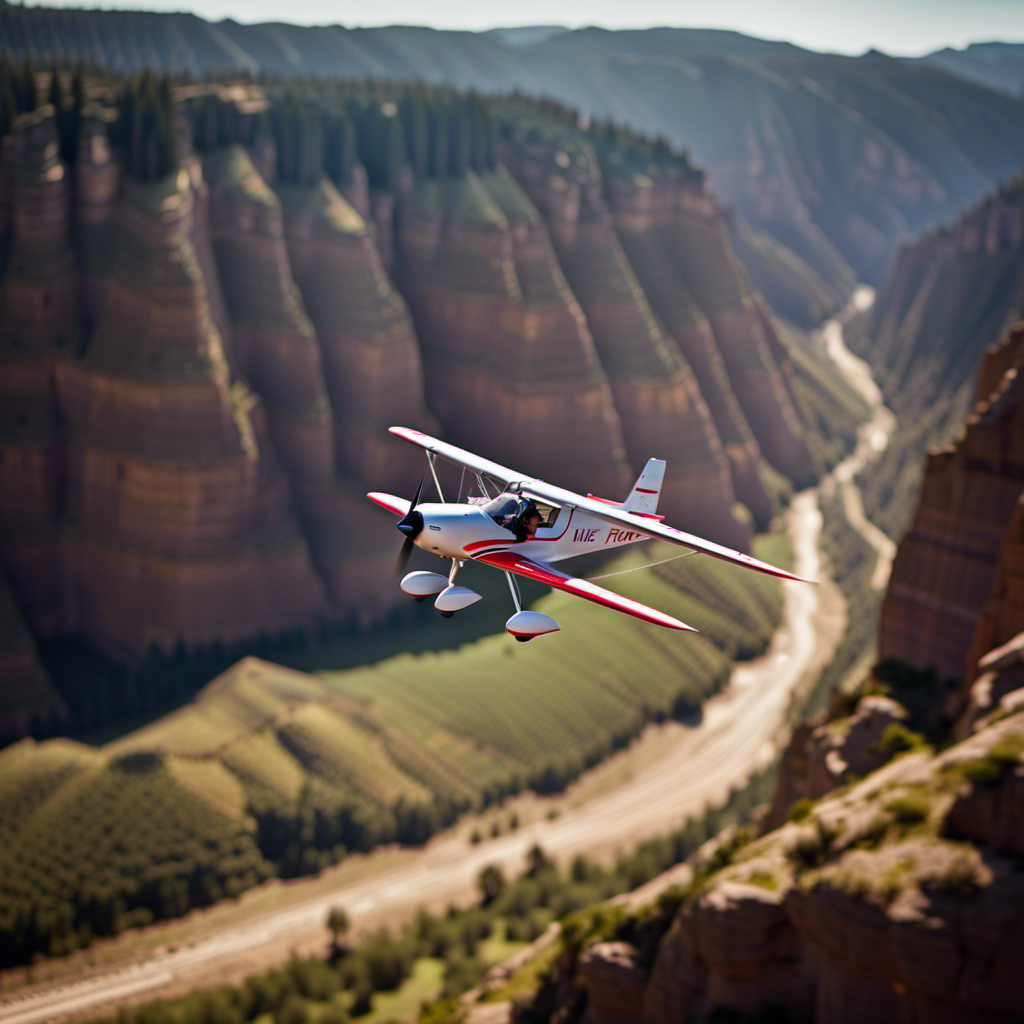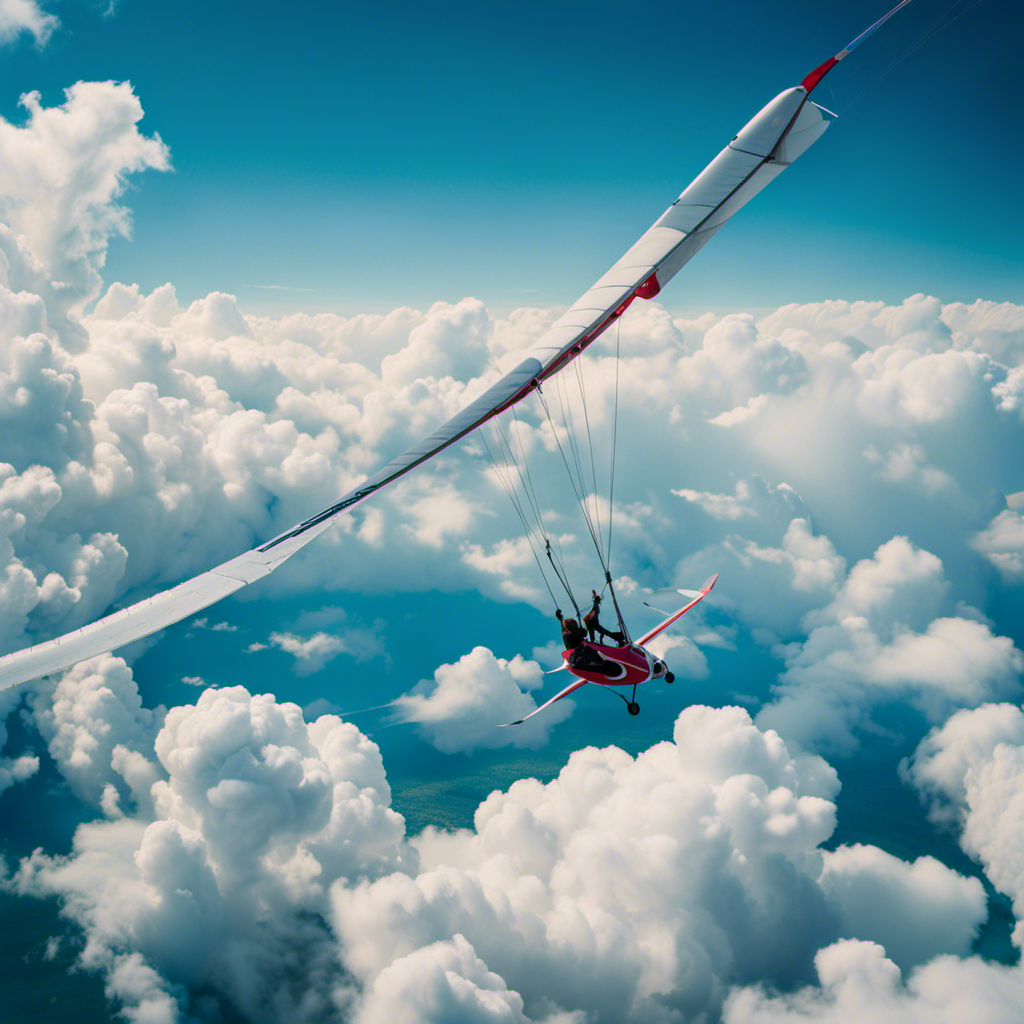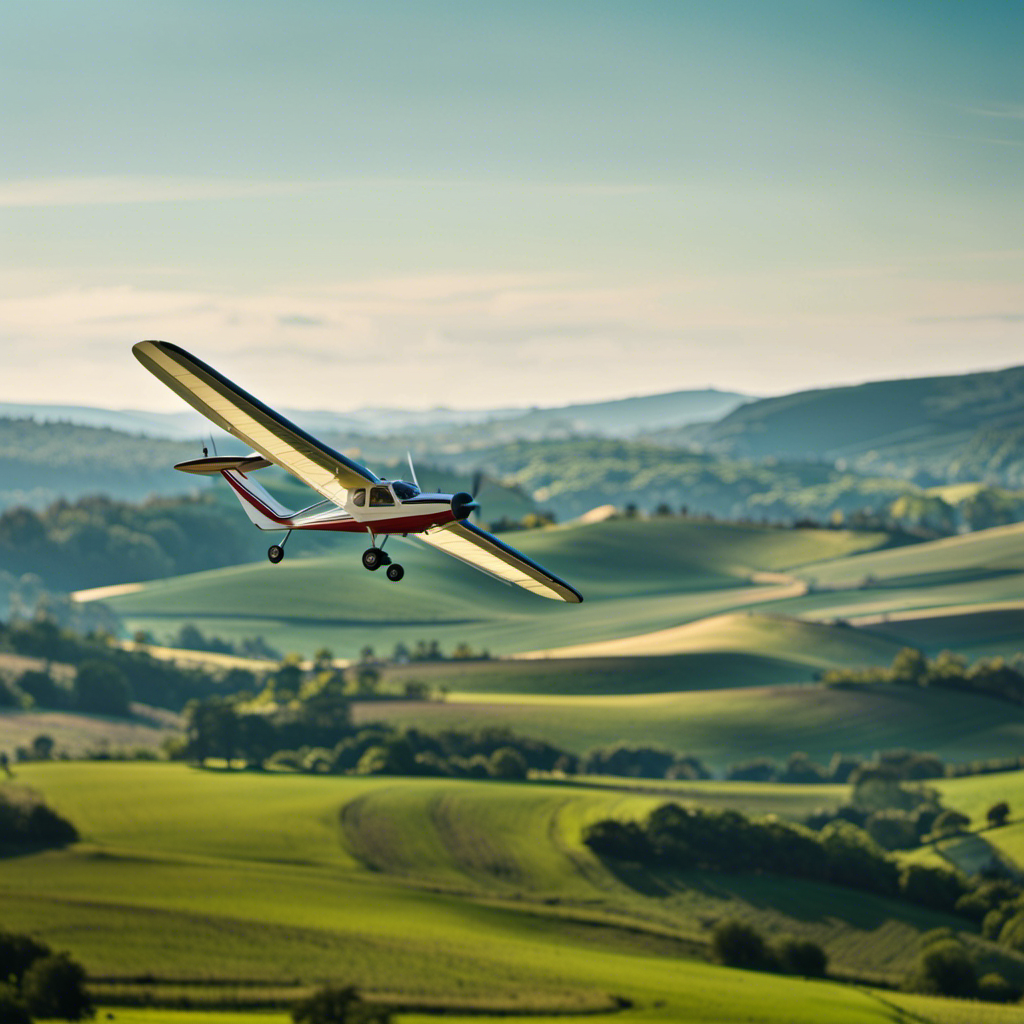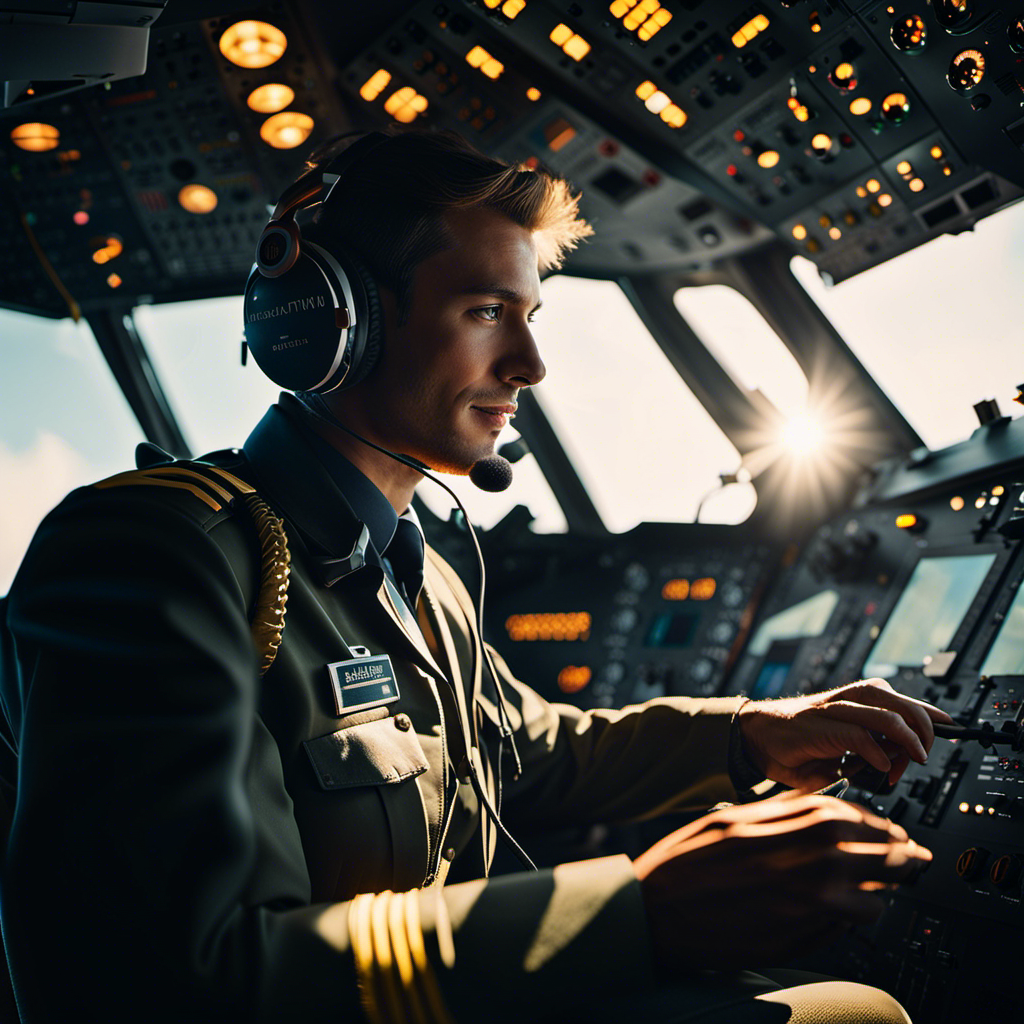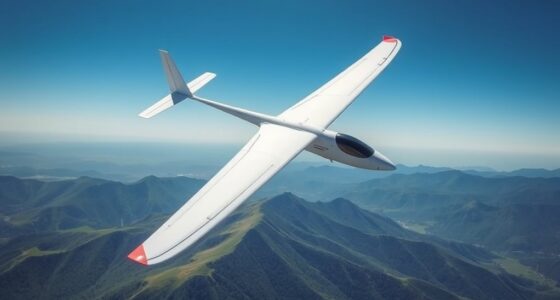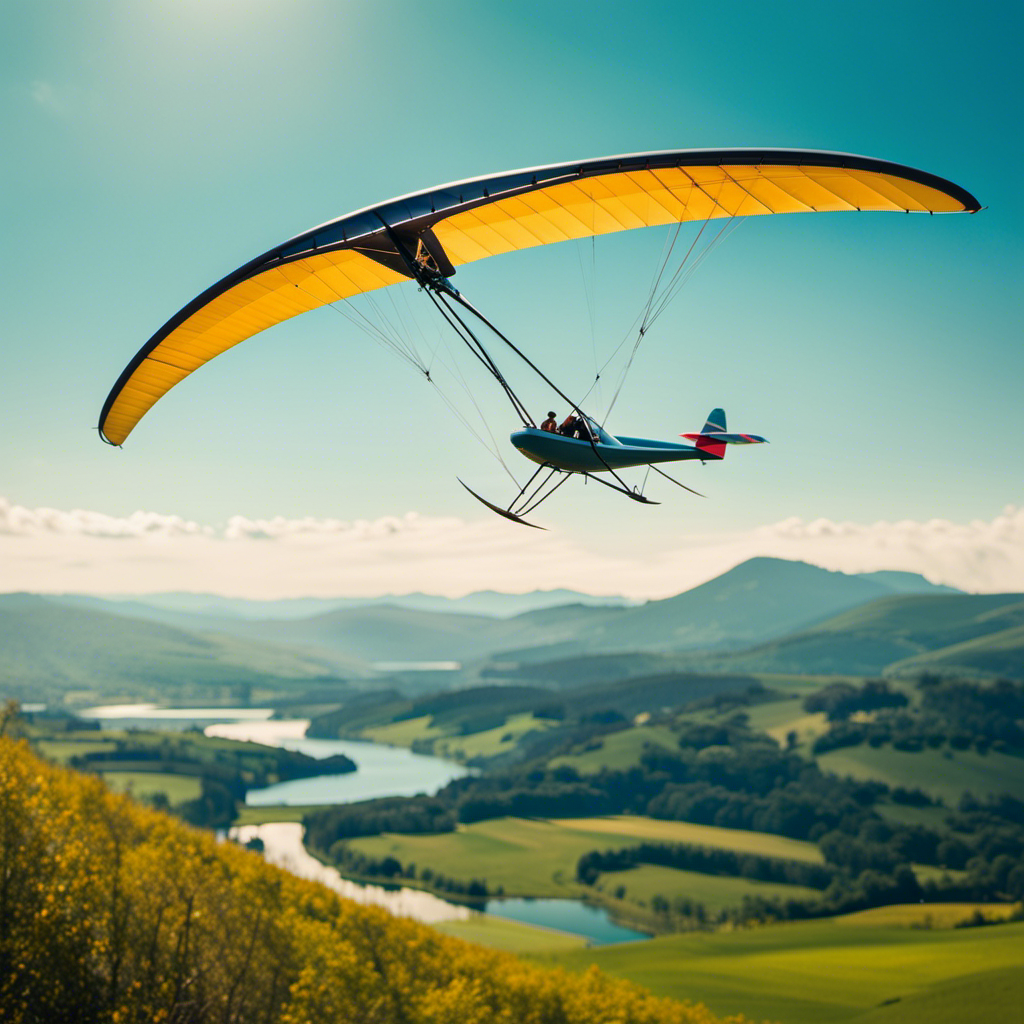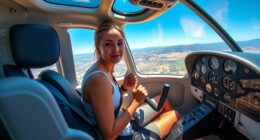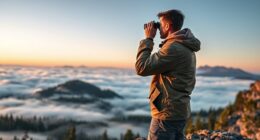I didn’t fully grasp the excitement of flying until I delved into the world of glider competitions. These competitions combine thrill and skill, allowing pilots to showcase their abilities in maneuvering and gaining altitude without the use of engines.
As someone who has always been drawn to adventure, I couldn’t resist the opportunity to delve into the world of glider competitions. In this article, we will explore the history, rules, and techniques of these competitions, as well as meet some of the top glider pilots who have mastered this breathtaking sport.
So buckle up, because we’re about to take flight into a world where the sky is the limit.
Key Takeaways
- Glider competitions have evolved over time, from focusing on distance and duration flights to more complex formats such as distance racing, aerobatic flying, cross-country racing, soaring, and spot landing.
- Glider competitions drive innovation in technology and techniques, benefiting the broader aviation industry.
- Safety is a top priority in glider competitions, with strict rules on airspace and safety equipment, and fair play is enforced to prevent cheating or the use of prohibited equipment.
- Glider competitions provide a thrilling experience for both pilots and spectators, showcasing pilots’ expertise in navigating and gaining altitude without an engine.
History of Glider Competitions
You might be wondering about the history of glider competitions and how they have evolved over time. Glider competitions have a rich history that dates back to the early 20th century. As glider technology evolved, so did the nature of these competitions.
The early glider competitions focused primarily on distance and duration flights. Pilots aimed to cover the longest distance or stay aloft for the longest period of time. However, as glider technology advanced, so did the complexity of the competitions.
The evolution of glider technology played a significant role in the development of glider competitions. Innovations such as the introduction of aerodynamic design principles, the use of lightweight materials, and the incorporation of advanced control systems have greatly improved the performance of gliders. This, in turn, has allowed for more challenging and exciting competitions.
Glider competitions have also had a profound impact on the aviation industry. These competitions have served as a testing ground for new technologies and techniques. The advancements made in glider design and performance have often been adopted by the broader aviation community, leading to improvements in aircraft design and efficiency.
Now that we understand the history and impact of glider competitions, let’s explore the different types of competitions that take place in this thrilling sport.
Types of Glider Competitions
Don’t miss out on the various types of glider contests available to participate in! Glider competitions offer a thrilling opportunity to showcase your skills and push the boundaries of flight. Whether you’re a seasoned competitor or a newcomer to the sport, there’s a competition format that will suit your flying style. Let’s take a closer look at the different types of glider competitions you can be a part of.
| Competition Format | Description | Scoring System |
|---|---|---|
| Distance Racing | Pilots compete to cover the longest distance within a specified time. | Distance covered |
| Aerobatic Flying | Participants perform a series of precision maneuvers and stunts. | Execution and Difficulty |
| Cross-Country Racing | Pilots race to complete a set course, navigating through waypoints. | Time taken and accuracy |
| Soaring | Competitors aim to stay airborne for the longest period of time. | Duration and altitude |
| Spot Landing | Pilots must land as close as possible to a designated target spot. | Distance from the target |
Each competition format has its own unique challenges and scoring systems. Distance racing focuses on covering the greatest distance, while aerobatic flying emphasizes executing precise maneuvers with difficulty. Cross-country racing tests pilots’ navigation skills, while soaring competitions require endurance and altitude management. Spot landing, on the other hand, demands accuracy and precision in landing.
Now that we’ve explored the different types of glider competitions, let’s delve into the rules and regulations that govern these exhilarating events.
Rules and Regulations
The rules and regulations of glider contests vary depending on the competition format chosen. Each format has its own set of guidelines that govern the conduct of the competition and ensure fair play.
Here are some key aspects to consider when it comes to the rules and regulations of glider competitions:
-
Safety: Safety is of utmost importance in glider contests. Rules regarding airspace, minimum flight altitudes, and mandatory safety equipment are strictly enforced to protect the participants and spectators.
-
Competition Format: Glider competitions can take various formats, such as distance racing, aerobatics, or spot landing. Each format has its specific rules and scoring system, which add excitement and challenge to the competition.
-
Fair Play: To maintain fairness, glider contests have rules against cheating or using prohibited equipment. Violations can result in disqualification or penalties, ensuring a level playing field for all participants.
These rules and regulations ensure that glider competitions are conducted in a safe and fair manner, providing an exhilarating experience for both pilots and spectators.
Transitioning into the next section on the skills required for glider competitions, one must understand that mastering these skills is essential to excel in this thrilling sport.
Skills Required for Glider Competitions
Transitioning into the skills required for glider contests, I must possess a strong understanding of aerodynamics and the ability to make precise and calculated maneuvers. Glider competitions require a unique set of strategies and tactics to succeed.
One of the key strategies is to carefully analyze the wind patterns and thermals to maximize lift and minimize drag. By studying the weather conditions and the topography of the competition area, I can plan my flight path accordingly. It is crucial to find the optimal balance between speed and altitude, as both factors play a significant role in achieving success.
In terms of tactics, glider pilots need to master the art of energy management. This involves efficiently using the available potential energy to maintain and gain altitude. By utilizing techniques such as thermalling, ridge soaring, and wave flying, I can effectively navigate through the air and gain altitude when needed. Additionally, maintaining an optimal glide ratio and adjusting the control surfaces at the right moments are essential for maximizing performance.
Transitioning into the subsequent section about techniques for navigating and gaining altitude, it is important to understand the various methods employed by glider pilots to harness the power of the air currents.
Techniques for Navigating and Gaining Altitude
To effectively navigate and gain altitude, you’ll need to master the techniques of thermalling, ridge soaring, and wave flying. These techniques are essential for glider pilots looking to maximize their flight time and explore new heights. Here are a few key strategies to keep in mind:
-
Thermalling: This technique involves circling within a thermal, or a column of rising air, to gain altitude. By carefully reading the clouds and feeling the varying wind directions, you can locate thermals and use them to climb higher into the sky.
-
Ridge Soaring: When flying close to a ridge or a mountain, you can take advantage of the upward wind that is deflected upwards by the obstacle. By skillfully maneuvering along the ridge, you can ride these updrafts and gain altitude without expending much energy.
-
Wave Flying: In certain weather conditions, mountain waves can form, creating powerful updrafts that can take you to incredible heights. By carefully studying the wind patterns and understanding how waves are formed, you can make use of these phenomena to gain altitude and extend your flight.
-
Cloud Flying: Clouds can indicate the presence of thermals and updrafts. By observing their shape, size, and movement, you can identify areas of lift and use them to your advantage.
-
Wave Riding: When flying in mountain wave conditions, you can ride the waves like a surfer rides a wave. By skillfully positioning yourself within the wave and adjusting your glider’s speed and attitude, you can maintain altitude and glide for long distances.
By mastering these techniques, you’ll be well-equipped to navigate the skies and gain altitude efficiently.
Now, let’s explore strategies for maximizing flight time without compromising safety or performance.
Strategies for Maximizing Flight Time
If you want to maximize your flight time, it’s important to utilize efficient soaring techniques and carefully manage your energy expenditure.
One key technique for efficient thermaling is to search for areas of lift, such as cumulus clouds or terrain features that generate thermals. Once you find a thermal, it’s essential to circle within it, staying close to the core where the lift is strongest. This allows you to gain altitude and conserve energy.
Another technique is to be mindful of your speed and angle of attack. Flying too fast can result in excess drag, while flying too slow can cause a loss of lift. By maintaining an optimal speed and angle of attack, you can reduce energy loss and prolong your flight time.
Additionally, managing your energy in flight involves making strategic decisions. For example, if you’re flying in a weak thermal, it may be more efficient to leave it early and search for a stronger one, rather than wasting energy in a marginal lift. It’s also important to plan your route and take advantage of ridge lift or wave lift, which can provide valuable energy without the need for thermals.
By employing these techniques and managing your energy wisely, you can extend your flight time and enjoy the thrill of gliding for longer distances.
As we explore strategies for maximizing flight time, it’s worth noting the connection between efficient soaring techniques and famous glider competitions around the world. These competitions bring together skilled pilots who employ various techniques to stay aloft for the longest possible duration.
Transitioning from discussing the strategies for maximizing flight time to exploring these renowned competitions, we can delve into the exciting world of glider racing and the incredible feats accomplished by pilots in these events.
Famous Glider Competitions Around the World
After mastering the strategies for maximizing flight time, it’s time to put those skills to the test in famous glider competitions around the world. These competitions not only showcase the talent and expertise of top glider pilots, but also provide an exhilarating experience for both participants and spectators alike. From the adrenaline-pumping races to the precision-based aerobatic displays, these competitions are a true celebration of the art of gliding.
To give you a glimpse into the world of glider competitions, here is a table highlighting some of the most renowned events:
| Competition Name | Location | Description |
|---|---|---|
| World Glider Aerobatic Championships | Toruń, Poland | Pilots perform intricate aerial maneuvers, showcasing their precision and control. |
| World Gliding Championships | Various locations | A multi-discipline event featuring tasks like distance flying, speed racing, and navigation. |
| European Gliding Championships | Various locations | A continental contest where pilots compete in different classes based on their experience. |
| Junior World Gliding Championships | Various locations | A platform for young glider pilots to showcase their skills and gain valuable experience. |
| Women’s World Gliding Championships | Various locations | This event promotes and encourages female participation in the sport of gliding. |
These competitions attract the best of the best in the gliding world, where pilots push the limits of their abilities and strive to be crowned champions. The intense competition, combined with the breathtaking aerial displays, make these events a must-see for any glider enthusiast.
Now, let’s delve into the profiles of these top glider pilots, and discover what makes them true masters of the skies.
Profiles of Top Glider Pilots
The profiles of these top glider pilots reveal their dedication, expertise, and love for the sport. These individuals have honed their skills through years of training and experience, making them the best in the field of glider piloting. Here are some remarkable glider pilots who have made a name for themselves in the industry:
-
John Davis: Ranked number one in the glider pilot rankings, John is known for his exceptional flying skills and strategic maneuvers in competitions. His precision and ability to read wind patterns set him apart from the rest.
-
Emily Collins: With a background in aerodynamics, Emily has a deep understanding of the physics behind gliding. Her technical knowledge and meticulous planning make her a formidable competitor.
-
Mark Thompson: A former military pilot, Mark brings his disciplined approach to glider competitions. His ability to handle high-stress situations and make split-second decisions makes him a force to be reckoned with.
-
Sarah Rodriguez: Having trained extensively in training programs for glider competitions, Sarah’s dedication and hard work have paid off. Her determination and passion for the sport shine through in her performances.
These top glider pilots serve as role models for aspiring pilots, showcasing the level of skill and dedication required to excel in this sport.
Now, let’s delve into the safety considerations in glider competitions, where the thrill of the sport meets the need for caution.
Safety Considerations in Glider Competitions
Let’s now explore the safety considerations that come into play during glider competitions, where caution is of utmost importance.
When it comes to glider competition equipment, there are several key factors to consider. First and foremost, the glider itself must be in top-notch condition, with regular maintenance and inspections to ensure its airworthiness. Additionally, pilots must be equipped with proper safety gear, including helmets and parachutes, in case of emergencies.
Weather conditions in glider competitions can be unpredictable and can pose significant risks. Pilots must be vigilant in monitoring weather patterns and forecasts, as well as understanding the effects of wind, thermals, and turbulence on their flight path. Strong winds can make launch and landing challenging, while thermals and turbulence can impact the stability of the glider. It is essential for pilots to make informed decisions and exercise caution when flying in adverse weather conditions.
Transitioning into the next section about ‘how to get started in glider competitions’ without using the word ‘step,’ it is crucial to have a solid foundation in glider flying before considering competition. Developing strong flying skills, gaining experience in different weather conditions, and obtaining proper training and certifications are vital steps towards entering the thrilling world of glider competitions.
How to Get Started in Glider Competitions
To begin your journey into the exhilarating world of glider competitions, it’s important to start by building a strong foundation in glider flying skills and gaining experience in various weather conditions. Here are three key steps to get started:
-
Invest in Training: Enroll in a reputable glider flying school or club to receive proper training. Learn the fundamentals of glider flying, navigation, and safety procedures. The more proficient you become, the more confident you’ll be in competition.
-
Gain Experience: Practice flying in different weather conditions, such as thermals, ridge soaring, and wave soaring. This will help you become familiar with the nuances of each condition, enhancing your ability to perform well during competitions.
-
Find Glider Competitions Near You: Research and identify glider competitions happening in your area. Check with local glider clubs, national gliding organizations, and online forums to find out about upcoming events. Participating in local competitions will allow you to gain experience, meet fellow glider pilots, and potentially attract sponsorships.
When it comes to getting sponsorship, it’s important to showcase your skills, achievements, and dedication to the sport. Create a compelling portfolio that includes your flying experience, competition results, and any media coverage you may have received. Reach out to potential sponsors, such as glider manufacturers, aviation companies, or local businesses, and highlight the benefits they would receive by supporting you. Remember, persistence and professionalism are key when seeking sponsorship opportunities.
Frequently Asked Questions
What are the health risks associated with participating in glider competitions?
Participating in glider competitions can pose health risks, but safety measures can minimize them. Some potential risks include accidents, injuries, and exposure to extreme weather conditions. It is essential to prioritize safety and follow proper guidelines to ensure a thrilling yet safe experience.
Are there any age restrictions for participating in glider competitions?
There are age restrictions for participating in glider competitions. According to a survey, the average age of participants is 35. It’s important to consider these restrictions to ensure the safety and well-being of everyone involved.
How do glider pilots communicate with each other during competitions?
Glider pilots communicate with each other during competitions using handheld radios. They use these radios to coordinate their positions, share information about weather conditions, and discuss competition strategies. Effective communication is crucial for success in glider competitions.
What kind of weather conditions are considered unsafe for glider competitions?
When it comes to glider competitions, we have to be cautious about certain weather conditions. Safety precautions are taken when conditions like strong winds, thunderstorms, and low visibility are present, as they can be unsafe for gliding.
Are there any specific requirements or restrictions for the gliders used in competitions?
There are specific requirements and restrictions for gliders used in competitions. These include weight limits, safety equipment, and design specifications. These rules ensure fair competition and prioritize the safety of the pilots and spectators.
Conclusion
As I soar through the sky, the rush of adrenaline courses through my veins, and the wind whispers secrets in my ears.
Glider competitions, where skill meets thrill, are a captivating world where pilots push the boundaries of what is possible.
From navigating treacherous winds to gaining altitude with finesse, these competitions demand both expertise and courage.
As I watch the top glider pilots gracefully dance among the clouds, I am reminded of the immense dedication and talent required to excel in this exhilarating sport.
So, if you’re ready to embark on an unforgettable journey, dive into the world of glider competitions and let your dreams take flight.
